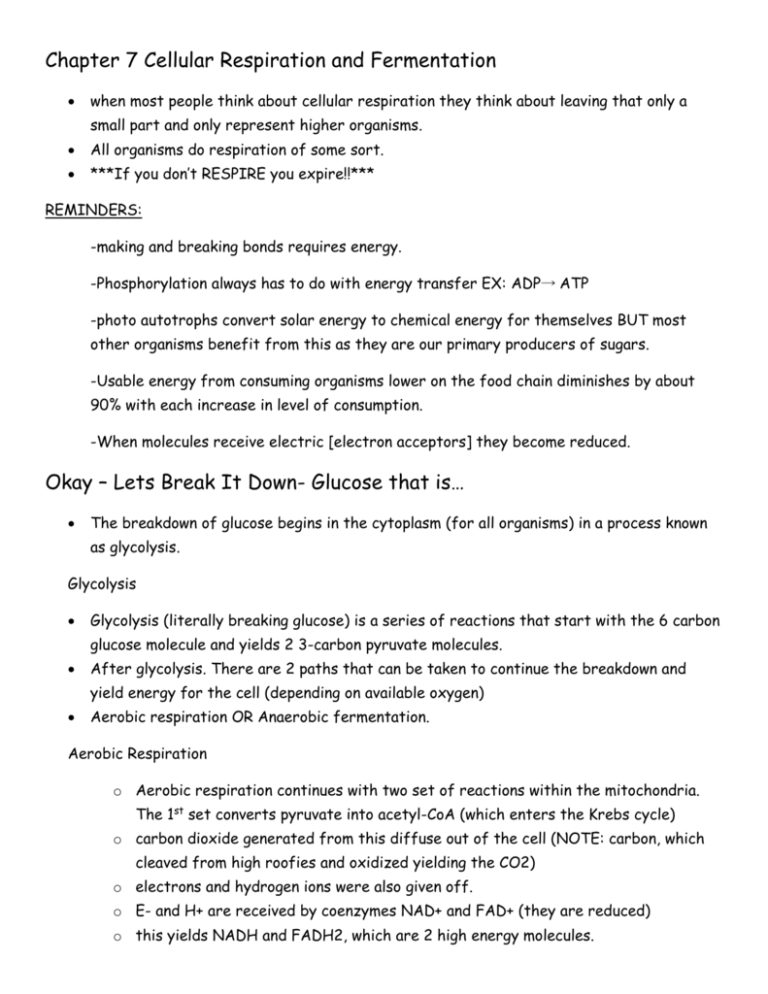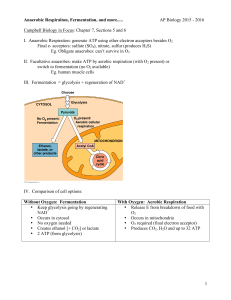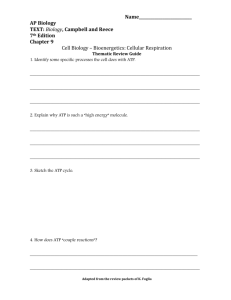Chapter 7 Notes Chapter 7 Cellular Respiration and Fermentation
advertisement

Chapter 7 Cellular Respiration and Fermentation when most people think about cellular respiration they think about leaving that only a small part and only represent higher organisms. All organisms do respiration of some sort. ***If you don’t RESPIRE you expire!!*** REMINDERS: -making and breaking bonds requires energy. -Phosphorylation always has to do with energy transfer EX: ADP→ ATP -photo autotrophs convert solar energy to chemical energy for themselves BUT most other organisms benefit from this as they are our primary producers of sugars. -Usable energy from consuming organisms lower on the food chain diminishes by about 90% with each increase in level of consumption. -When molecules receive electric [electron acceptors] they become reduced. Okay – Lets Break It Down- Glucose that is… The breakdown of glucose begins in the cytoplasm (for all organisms) in a process known as glycolysis. Glycolysis Glycolysis (literally breaking glucose) is a series of reactions that start with the 6 carbon glucose molecule and yields 2 3-carbon pyruvate molecules. After glycolysis. There are 2 paths that can be taken to continue the breakdown and yield energy for the cell (depending on available oxygen) Aerobic respiration OR Anaerobic fermentation. Aerobic Respiration o Aerobic respiration continues with two set of reactions within the mitochondria. The 1st set converts pyruvate into acetyl-CoA (which enters the Krebs cycle) o carbon dioxide generated from this diffuse out of the cell (NOTE: carbon, which cleaved from high roofies and oxidized yielding the CO2) o electrons and hydrogen ions were also given off. o E- and H+ are received by coenzymes NAD+ and FAD+ (they are reduced) o this yields NADH and FADH2, which are 2 high energy molecules. o Only the tiny bit of ATP has been created so far. The Krebs Cycle 2nd stage o acetylCoA enters the Krebs cycle. o It is broken down by a series of reactions, which yield 6 CO2 molecules and 2 ATP, 6 NADH, and 2 FADH2 Electron Transfer Phosphorylation 3rd stage o coenzymes NADH and NADH2 donate hydrogen ions and electrons to the electronic transfer chains (ETC) embedded in the inner mitochondrial membrane. o The flow of electrons down the ETC facilitates hydrogen ion pumps to create a gradient so that ATP synthase may generate ATP The overall yields of aerobic respiration are 36 ATP molecules of glucose molecule, however, results may vary. 60% of the energy is lost as metabolic sheet These are truly exergonic reactions. Anaerobic Fermentation We begin with pyruvate from glycolysis and we remain in the cytoplasm of the cell. 2 options Alcoholic Fermentation OR Lactic Acid Fermentation Lactic Acid Fermentation also called lactate electrons and hydrogen ions from NADH transport directly to pyruvate converting to a 3 carbon lactate molecule, this is the oxidized form of lactic acid. Some lactate fermenters spoil food, others preserve it. We use bacteria which use this process to create buttermilk cheese and yogurt. Yeast fermenters produce pickles sauerkraut and kimchee. Red versus white muscle fibers. White muscle fibers contain few mitochondria and no myoglobin, so they do not hold much oxygen and therefore do not carry out a lot of aerobic respiration. Most ATP in white muscle fiber is produced by lactate fermentation useful for, quick strenuous activities such as sprinting or weightlifting. Red fibers have many mitochondria and produce ATP by aerobic respiration. These fibers sustain prolonged activity and have an abundance of myoglobin, a protein which stores oxygen. Luckily, we humans have a mixture of both red and white muscle fibers to make the best of both worlds Ethyl Alcohol Fermentation –Alcoholic Fermentation the pyruvate from glycolysis is split into carbon dioxide and a 2-carbon acetyl aldehyde electrons and hydrogen ions are transferred from NADH to the acetyl aldehyde forming NAD+ and ethanol. Alcoholic fermentation in the fungus yeast helps us produce beer, wine and bread. Ethanol produced by the fermenting used cells makes beer alcoholic and carbon dioxide makes it bubbly








